Intertrochanteric fracture of the femur, also known as intertrochanteric fracture, is an extra-articular capsule fracture. The main manifestations of intertrochanteric fracture are significant local pain and swelling, extensive ecchymosis, inability of the patient to stand or walk, significant shortening, internal and external rotation deformity of the affected limb, and limitation of active and passive movement of the hip joint in any direction.
Epidemiology
1. Most of them are related to osteoporosis, most commonly in the elderly, more women than men.
2. The incidence is related to race, gender and region.
3. common injury in the elderly, the mean age of intertrochanteric fracture of femur is 75.2 years. There was no significant difference in the age of intertrochanteric fracture between men and women.
4. Due to the rich blood flow in the trochanter, the fracture rarely does not heal, but it is easy to occur hip inversion, and there are more complications caused by long-term bed rest in elderly patients, and the morbidity and mortality rate is 15%-20%, so it is called the last fracture in the elderly.
Mechanism of injury
1. Young adults are mostly high-energy injuries, should pay attention to brain, chest, abdomen and other parts of the injury; elderly people are mostly aging function of the limbs coordination response agility decline and fall caused by.
2. Direct violence: direct impact on the greater trochanter area. If the body falls to the ground with lateral force when falling.
3. Indirect violence: the body is twisted during the fall, and the hip is subjected to the stress of inversion and forward angle at the same time.
4. Pathological fracture, one of the common bone tumors.
5. Intertrochanteric fracture is mainly formed by indirect violence.
Clinical manifestations
1. The basic presentation is the same as that of femoral neck fracture, with local pain, swelling and functional limitation of the affected limb.
2. Because it is an extra-articular capsule fracture, there is no restriction of the joint capsule, so the deformity of shortened external rotation (90 degrees) of the lower limb is more serious.
3. Axial percussion pain.
4. Local hematoma is relatively severe, and there may be more extensive subcutaneous bruising.
5. In elderly patients, they tend to be older than femoral neck patients, and a significant proportion of patients have had a previous stroke.
Diagnosis
History of obvious trauma, pain in the affected limb, and limitation of movement. Shortening and external rotation deformity of the lower limb is evident up to 90°. X-ray examination is often required to establish the diagnosis and typing is based on the radiographs. The symptoms of intertrochanteric fracture are similar to those of femoral neck fracture, but the latter is less severe than the former in terms of local pain, swelling, loss of function, and shortening of the affected limb, and the affected limb mostly has mild hip flexion and knee flexion and external rotation deformity, usually between 45°-60°.
Type
The AO and Evans-Jensen fractures are the two most commonly used fracture types, and of these two, the AO fracture type is the most common.
Evans-Jensen typing
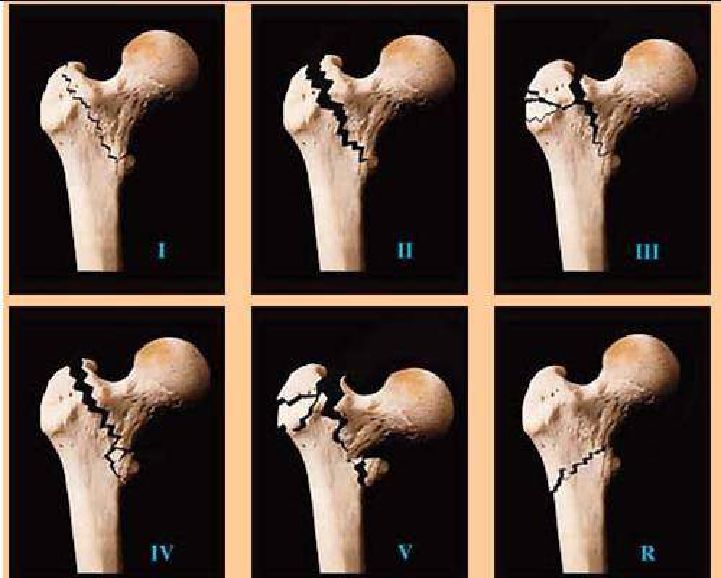
Type I: Simple intertrochanteric fracture with a fracture line sloping from superior to inferior, without displacement and stability.
Type II: Displacement combined with a small rotor avulsion fracture, but the femoral spur is intact (the femoral spur is a dense bone plate located deep inside the femoral neck and body junction of the small rotor.
Type III: Combined greater trochanteric fracture with fracture accumulation of the femoral spur, with displacement, often with posterior inter-rotor fracture.
Type IV: 3-part fracture combined with a comminuted fracture of the lesser trochanter, which may present with a burst fracture of the femoral neck and coronal surface of the greater trochanter.
Type V: posterior lateral and medial unsupported fracture (combination of types III and IV).
Type R: an anterior intertrochanteric fracture with an oblique fracture line from superior medial to inferior lateral, which may be associated with a small rotor fracture and destruction of the femoral spine.
AO typing

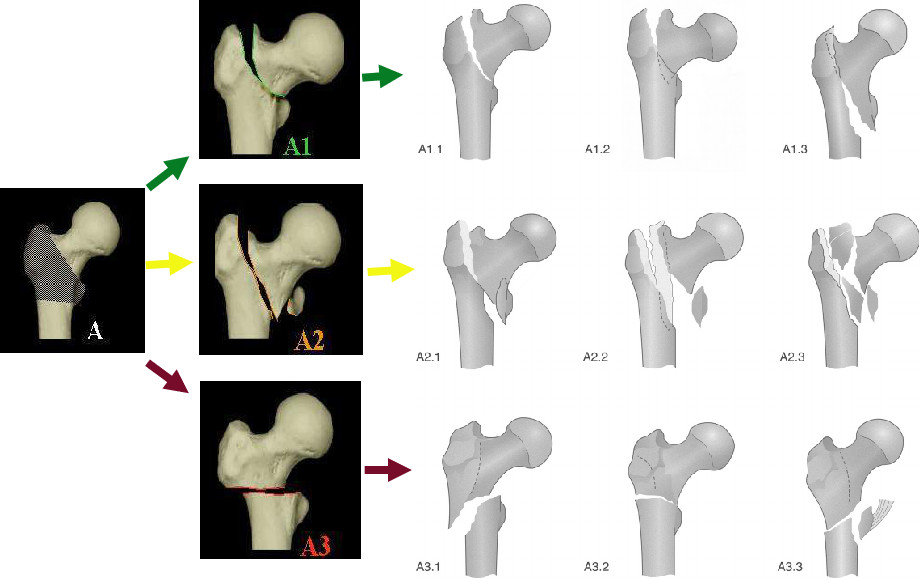
A1.1 The fracture line passes through the inter-rotor line
A1.2 Fracture passing through the greater trochanter
A1.3 Fracture passing below the lesser trochanter
A2.1 Fracture with 1 comminuted bone fragment
A2.2 Fracture with multiple comminuted bone fragments
A2.3 Fracture extending more than 1 cm below the lesser trochanter
A3.1 Simple oblique shape
A3.2 Simple transverse shape
A3.3 Comminuted
Treatments
The stability of internal fixation of fractures is generally dependent on five factors: the quality of the bone, the type of fracture, the reduction, the choice of internal fixation, and the position of the internal fixation in relation to the bone. Fracture repositioning is important for stability after internal fixation and should aim to achieve either an anatomic reposition or a stable non-anatomic reposition. In summary, the goal of repositioning is to obtain fracture stability. The method of repositioning can be closed or incisional. Regardless of the complexity of the fracture type, closed reduction should be tried first.
Power Hip Dowel (DHS)

Main advantages of DHS Power Hip Screws.
The screw has a strong fixation effect within the femoral head, even in the case of osteoporosis.
The gliding mechanism in the sleeve prevents penetration of the nail end into the femoral head or acetabulum and direct transmission of negative gravity to the bone.
The power gliding mechanism keeps the fracture in place and reduces non-union.
It has a dual function of compression and gliding, with a dynamic and static compression effect.
Power Hip Dowel (DCS)
DCS and 95 degree cutting plates for anticrotal fractures:
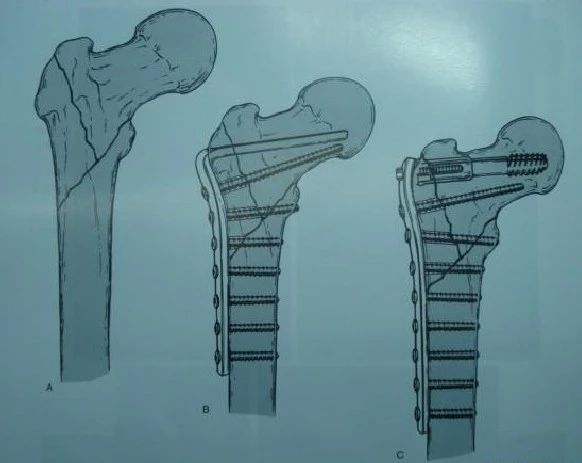
The main advantages of the DCS power condylar screw are.
It can correctly select the entry point of the screw according to the specific situation of the fracture, and the operation is convenient.
The power compression tension screw is at a right angle to the plate, which meets the biomechanical requirements of the hip. During weight-bearing, the negative force is first applied to the short arm of the plate and then dispersed to each screw, so that the stress is dispersed and the fixation is exceptionally firm.
The slightly larger number of DCS screws at the fracture increases the firmness, and the fracture area can be bridged and fixed, thus reducing the incidence of postoperative complications.
Proximal Femoral Locking Intramedullary Nail (PFN)

Advantages of PFN fixation.
Smaller nail diameter (typically 9mm), can be driven in without dilation. (superior to the thicker caudal end of the Gamma nail - 17mm)
The proximal end of the PFN has an approximate camber of 6 degrees, reducing the angle of valgus and eliminating the need for strong internal retraction during traction.
The upper end allows for the placement of two screws into the femoral head, with the addition of an anti-rotation screw and double nail bearing in the femoral neck, which increases fatigue resistance.
The distance between the distal locking hole and the distal end of the main nail (tapered extension) is longer, which can reduce the stress concentration in the femoral stem.
Relatively less trauma.
Gammar nails
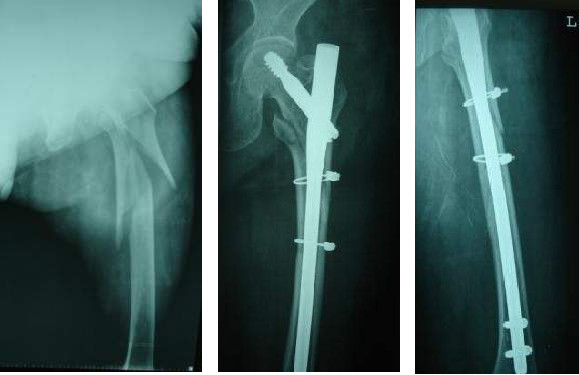
Advantages of Gammar nail fixation.
It is a minimally invasive intramedullary fixation method with a small incision and minimal trauma.
The Gamma nail firmly unites the upper femur and the femoral neck through the combination of the intramedullary nail and tension screw, and the intramedullary nail is fixed by the distal self-locking nail, which prevents rotation and shortening displacement and provides reliable fixation.
Gammar's improvement - PFNA
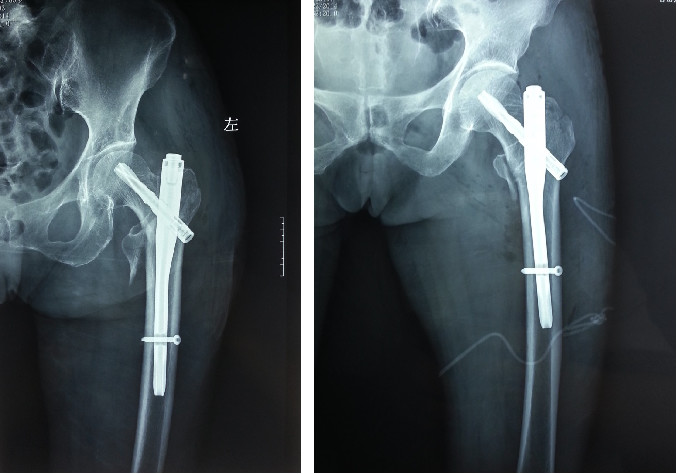
Internal fixator selection (PFNA).
An ideal built-in for unstable intertrochanteric fractures of the femur.
It firmly fixes the femoral head and neck and prevents rotation of the fracture end.
Prevents complications such as collapse due to bone resorption after loss of medial support, inversion deformity, and cutting out of the femoral head with the insert.
Suitable for almost all intertrochanteric fractures, especially for unstable fractures (e.g. anterior intertrochanteric fractures) and combined osteoporosis.
There is still a certain incidence of complications, such as femoral head avulsion, which makes it impossible to replace other internal fixations.
Artificial Joint Replacement
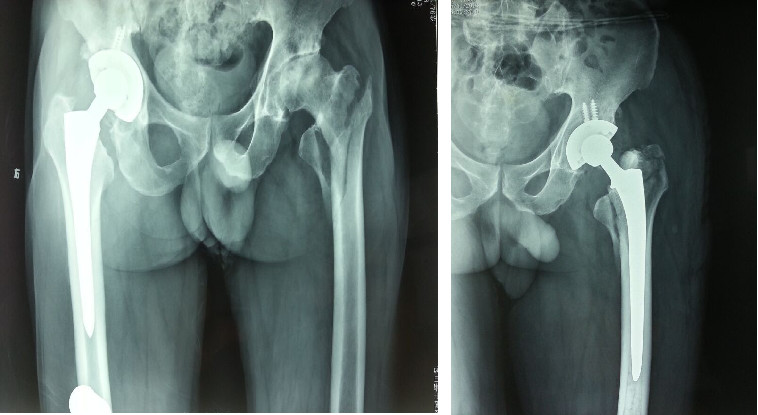
Indications for artificial joint replacement surgery for intertrochanteric fracture of the femur:
Age above 80 years.
Comminuted and unstable intertrochanteric fracture.
Bone osteoporosis is obvious, and internal fixation is difficult to fix effectively.
No significant limitation of hip or knee movement before the injury.
The whole body condition can tolerate the surgical treatment.
Patients who cannot be treated in bed for a long time.
Advantages: early post-operative positioning on the ground. Avoid bed-ridden complications. Extend survival time and improve quality of life.
How to Buy Orthopaedic Implants and Orthopaedic Instruments?
For CZMEDITECH, we have a very complete product line of orthopedic surgery implants and corresponding instruments, the products including spine implants, intramedullary nails, trauma plate, locking plate, cranial-maxillofacial, prosthesis, power tools, external fixators, arthroscopy, veterinary care and their supporting instrument sets.
In addition, we are committed to continuously developing new products and expanding product lines, so as to meet the surgical needs of more doctors and patients, and also make our company more competitive in the whole global orthopedic implants and instruments industry.
We export worldwide, so you can contact us at email address song@orthopedic-china.com for a free quote, or send a message on WhatsApp for a quick response +86-18112515727.
If want to know more information,click CZMEDITECH to find more details.
English
Français
Русский
Español
العربية
Português
Deutsch
italiano
日本語
한국어
Nederlands
Tiếng Việt
ไทย
Polski
Türkçe
አማርኛ
ພາສາລາວ
ភាសាខ្មែរ
Bahasa Melayu
ဗမာစာ
தமிழ்
Filipino
Bahasa Indonesia
magyar
Română
Čeština
Монгол
қазақ
Српски
हिन्दी
فارسی
Kiswahili
Slovenčina
Slovenščina
Norsk
Svenska
українська
Ελληνικά
Suomi
Հայերեն
עברית
Latine
Dansk
اردو
Shqip
বাংলা
Hrvatski
Afrikaans
Gaeilge
Eesti keel
Māori
नेपाली
Oʻzbekcha
latviešu
অসমীয়া
Aymara
Azərbaycan dili
Bamanankan
Euskara
Беларуская мова
भोजपुरी
Bosanski
Български
Català
Cebuano
Corsu
ދިވެހި
डोग्रिड ने दी
Esperanto
Eʋegbe
Frysk
Galego
ქართული
guarani
ગુજરાતી
Kreyòl ayisyen
Hausa
ʻŌlelo Hawaiʻi
Hmoob
íslenska
Igbo
Ilocano
Basa Jawa
ಕನ್ನಡ
Kinyarwanda
गोंगेन हें नांव
Krio we dɛn kɔl Krio
Kurdî
Kurdî
Кыргызча
Lingala
Lietuvių
Oluganda
Lëtzebuergesch
Македонски
मैथिली
Malagasy
മലയാളം
Malti
मराठी
ꯃꯦꯇꯥꯏ (ꯃꯅꯤꯄꯨꯔꯤ) ꯴.
Mizo tawng
Chichewa
ଓଡ଼ିଆ
Afaan Oromoo
پښتو
ਪੰਜਾਬੀ
Runasimi
Gagana Samoa
संस्कृत
Gaelo Albannach
Sepeti
Sesotho
chiShona
سنڌي
Soomaali
Basa Sunda
Wikang Tagalog
Тоҷикӣ
Татарча
తెలుగు
ትግንያውያን
Xitsonga
Türkmençe
संस्कृत
ئۇيغۇرچە
Cymraeg
isiXhosa
ייִדיש
Yorùbá
isiZulu



















